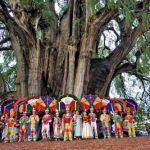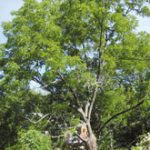
I sit on the tiled floor of my back porch, listening to the mourning doves hoo, hoo, hoo and the other little birds cheep, chirp, and twitter, trying to write something profound about my lime tree. My big, perpetually dusty, labradoodle, a failed foster named Güera (white girl), pushes her irresistibly cute face into mine, harrumphing and squeaking and wagging her entire body, her breath as terrible as ever. I appreciate the distraction. Profundity is not my forte, but there is something life-altering about my lime tree experience.
I inherited the tree with my house. Like my neighbors, it is well-established and agrees with the sunny climes of my adopted homeland: Chapala, Jalisco, Mexico. Every August it bears hundreds of superball-sized limes that yellow when they ripen. I don’t know the species, but their juice makes a key lime pie that tastes exactly like the one my Aunt Merili, a Key West Conch, taught me how to make. It is not a huge tree, maybe 12 feet tall and about the same wide. Planted only six feet from the back of my neighbor’s house, sun from the west is all but blocked off. In response, the tree slopes toward this barrier, exposing as much of itself as possible to the sun’s east-to-west path.
I read a lot about how to care for this tree. I scoured gardening blogs, university growing guides, and almanacs. Much of the information was useless. My neighbors offered better advice based on the success of their own lime trees, but this too was inadequate. What I discovered was helping a growing thing thrive is hyper-specific to its immediate environment and ever-changing needs. Both the amount of water and fertilizer depended on the timing and intensity of the summer rains. I noticed the bee pollinators (and thus the limes) were much more abundant the year the baby sunrose plants that drape the low retaining wall behind the tree bloomed in profusion. The shape of the tree shifted when the neighbor behind me trimmed his pine tree, reminding me how much the tree loves the sun. There were countless other symbiotic relationships I couldn’t begin to fathom.
My relationship with this lime tree has me questioning Western knowledge systems and their reliance on written, unchangeable facts. Even the motive of the sanctioned advice is suspect. It centers around maximum yield rather than overall tree health. In this mode, trees are reduced to fruit manufacturers, with the end product being a saleable commodity. I swear, though (admittedly there may have been some plant medicine involved) the lime tree made it clear to me that if I were stingy with the fruits of our combined labor, he (assuming the Spanish designation of male for tree) would signal the bees to stop pollinating. No worries there. My favorite part of growing limes (besides the pie) is giving away bags of them to my neighbors. Creation, my lime tree reminds me, is a beautifully complex system of ever-evolving exchanges, none of which are fixed.
The lime tree has also taught me the educational value of observation. Uncoerced learning is foreign to me. There has almost always been a carrot or stick involved with my knowledge acquisition. A grade to be earned, or a test to pass, or a boss to obey. I do read for pleasure and certainly have learned from following my curiosity, but this learning, dispensed by experts, distributed by gatekeepers, and copyrighted cannot by its nature evolve without the experience of the reader. It is frozen in time and space and separate from both. Observation exists only in the moment, and the conclusions we draw from observation often change based on further observation. One windy spring, for example, there were far fewer bees than normal, which, I believed, would lead to fewer limes. However, I had a bumper crop that year. My lime tree, it seems, is self-pollinating, and the wind knocked pollen from the anthers to the gooey stigmas of its little white flowers.
This last part gets mystical (and no plant medicine was involved). My lime tree actively comforted me while I grieved the terminal illness and then death of my beloved dog, Chuy. I sat on my back porch every afternoon on those last weeks of Chuy’s life, allowing my sadness to dissipate into birdsong and the rush of wind through the pine and orchid trees. On the day that he could no longer move, my sadness heaved out of me in waves. The lime tree shimmered in response, seemingly absorbing my anguish and reflecting back a sublime reassurance. When the day came that I had to lay Chuy to rest, I of course chose to bury him beneath the lime tree. I placed the last stone at the base of the tree and rested my palm against the thin trunk. An electric warmth coursed up my arm and through my body enveloping me as intimately as a hug from my mom. Chuy was fine. I would be fine. And the natural cycles of flowering, fruiting, and rest will carry us all home.
- Local Artist Profile: Blanca Ruth Casanova - December 1, 2023
- Local Profile: Francisco Urzua Ines - September 30, 2023
- Thank You Marcus Berlin Willoughby - May 31, 2023









